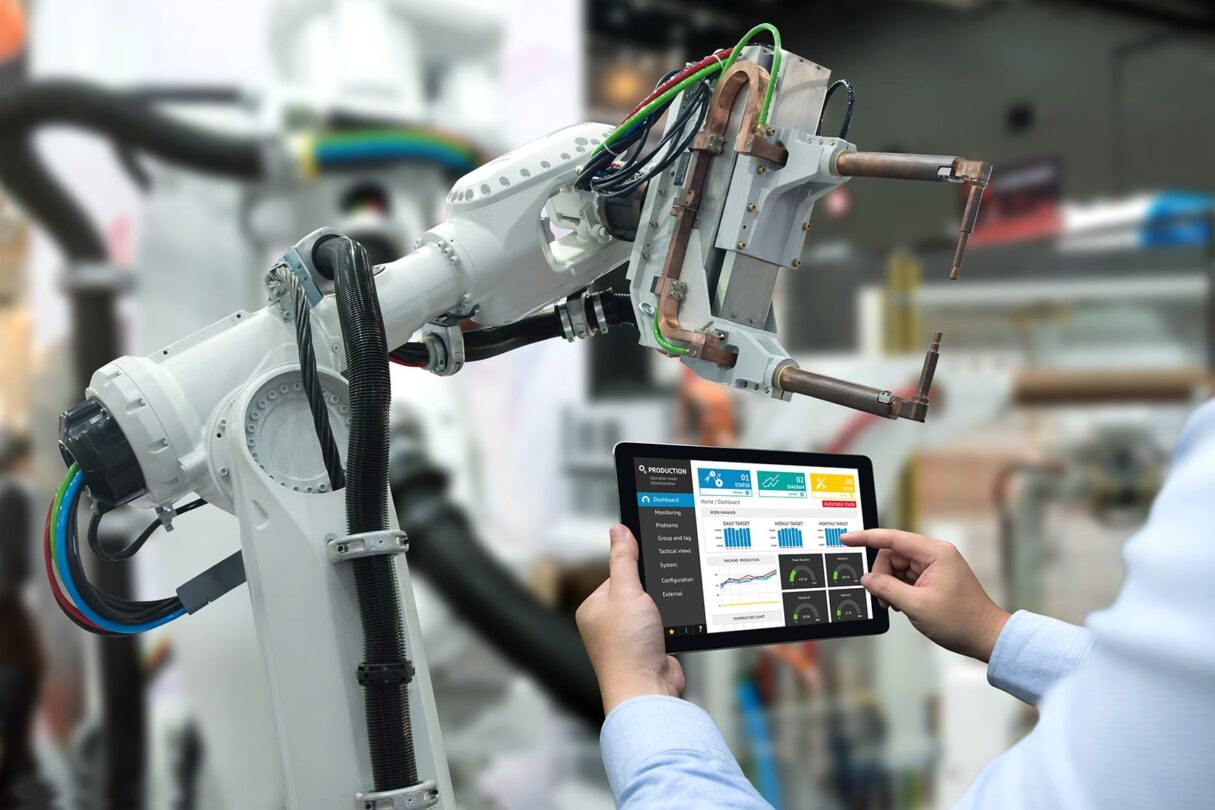Technology & Innovation
How enterprise software can harness AI for smart manufacturing

Digital manufacturing and Industry 4.0 are nothing new. 3D printing/additive manufacturing, industrial robots, self-driving vehicles, drones, augmented/virtual reality, Industrial Internet of Things (IIOT), edge computing, and more are making manufacturing more agile, flexible, and personalized. So-called smart factories are based on a set of manufacturing concepts intended to streamline business. These optimizing principles include full connectivity, agility, lot size of one, and parts, subassemblies, and products moving on automated guided vehicles (AGVs).
Many of these new technologies have negative connotations for the workforce. Humans feel threatened that they may be replaced. But what about artificial intelligence (AI) methods like machine learning and predictive analytics? Applied in the realm of manufacturing enterprise software, these methods won’t take away people’s jobs but can augment human capacity. AI tools lend themselves well to pattern recognition exercises (which employees find tedious) and suggest next best actions based on certain rules, so people to focus on more value-adding and strategic work.
AI for predictive maintenance and service contracts
In the area of predictive maintenance, manufacturers can hope to achieve lower maintenance costs while improving uptime. Advanced pattern recognition and machine learning algorithms are key to optimizing customer service levels in this way. Research shows that automotive manufacturing can suffer from downtime losses amounting to $1.3 million per hour. Surely technological advances can help mitigate these losses.
Predictive maintenance applications are deployed on edge devices (access points into the network) and Internet of Things (IoT) sensors. The operating data is continuously gathered, cleansed, analyzed, and stored. Predictive and machine learning algorithms can then monitor the health of critical components. When the AI model predicts a failure, it sends a request for maintenance that typically includes the failure confidence level for the expected failure time.
Machinery sensor data streams are input into the software’s advanced modeling process. By comparing real-time operating data against the model, the technology can establish expected equipment behavior and issue alerts upon subtle deviations from it. This setup can provide early warnings of equipment issues long before they negatively impact the business. If operators can catch issues early, the savings are potentially massive. Research suggests 17% lower maintenance costs, 25% less downtime, 16% longer equipment life expectancy, among other quantitative measures.
But the concept of predictive maintenance of internal assets can also be extended to monitoring products that were purchased and are in use at the customer site. Via IoT sensors, one can monitor the product’s performance and the users’ habits, and be predictive and proactive about it via AI algorithms. Think of, for example, a washing machine manufacturer knowing the exact machine part that failed in someone’s home. Don’t we all hate waiting for a repair technician to diagnose the issue, only to tell us that the proper parts will only be available in a couple of weeks? AI can streamline this process.
Even better, what if the appliance manufacturer could predict the likely failure and act on it before the malfunction happens, to the delight of the customer? Some may regard this as a Big Brother-like privacy issue, but others will accept that imposition for the convenience it offers. Many families cannot function a few days without a washing machine or dishwasher.
By offering service level agreement (SLA)-based service contracts, manufacturers can increase their revenue streams beyond the mere one-time sale of a product. Some companies and pundits refer to this offering as “product as a service” and generate revenues from product leases (e.g., selling cubic feet instead of selling compressors or selling hours of engine operation instead of selling engines). For example, Apple has reported higher profit margins for services, by almost 60%.
This intelligent setup can increase the manufacturer’s value proposition with services that increase the advantages and decrease the difficulties in using the product. Companies can also create an ongoing relationship with the customer via services that go beyond the simple sale of the product. Last but not least, by sharing the relevant product and service data, the manufacturer can equip its partners and distributors with important know-how.
Other possible AI use cases in manufacturing
Machine learning can improve forecasting and demand-driven and sensing-based planning, especially for long-tail items (with irregular demand), brand new items, promotions, and incorporating social sentiments. Some consumer goods manufacturers have reported a 50% drop in manual intervention for planning and 10% inventory reductions due to using those tools. Predictive analytics tools in enterprise resource planning (ERP) and supply chain management (SCM) software may also be used to predict specific supply risks (e.g., declining quality, solvency, and other supplier issues).
Deep-learning visual inspection gadgets coupled with machine learning algorithms can help with detecting and predicting quality patterns and issues in statistical process control (SPC). Manufacturers could reduce scrap rates based on machine learning-based root-cause analysis and reduce testing costs using AI optimization methods. In-process quality control and parts availability are interesting AI scenarios, as they involve an intersection of data acquisition, contextualization, analysis, and workflow rules.
When deployed in shop floor order management, AI algorithms can recommend the most efficient path for moving materials, while minimizing energy consumption and functional or quality checks. As the product configuration or shop floor environment changes, the enterprise software can re-plan the next location for a production machine or an assembly or inspection station, based on availability. AI could also be used for predictive scrapping of parts in an assembly line, with the goal of automatically scrapping parts as early as possible to reduce manufacturing costs by avoiding unnecessary rework.
In the future, AI technologies such as pattern recognition or outlier detection could be used on production, quality, and inventory data to provide surprising information, which the traditional enterprise software user would not have systematically looked for and may not have expected or detected. This data could then be fed into the cloud enterprise system and overlaid with production, process, or labor data at the business intelligence (BI) level, where AI technologies can be used to glean further valuable insights and prescriptions.
How should enterprise software adapt to AI?
In general, any process that generates enough data has the potential to leverage AI algorithms. Manufacturers could use AI tools to grow faster and improve product quality and productivity, while still being able to afford short production runs to delight fickle customers.
To that end, how must ERP, SCM, or manufacturing execution system (MES) software architecture change to accommodate AI? Not as much as you might think. In fact, AI and machine learning are not new, and enterprise software systems have always included optimizers and solvers (remember the erstwhile i2 or ILOG?).
Rules engines and algorithms like linear regression, neural topic modeling, K-means clustering, boosted decision, etc. have long existed. But these solvers had to perform their lengthy what-if scenarios and number crunching outside of ERP software to produce any recommendations; the results were then imported back into the ERP system for further action.
Today’s market demands results faster and in near real-time. Ideally, those results come via embedded in-memory computing with the ability to process large volumes of data in an instant. The IoT concepts are really just integration and analytics on steroids, from ever more sources and even more data streams.
Modern enterprise software platforms will thus need to use technologies and services (i.e., RESTful application programming interface [API]- and microservices-based architecture) that support easy integration and abstraction. Those services must also foster advanced software personalization, embedded analytics, and the ability to extend apps without inhibiting the ability to upgrade. Modern ERP and other enterprise systems will preferably have built-in AI, rules, and workflow engines, which will enable predictive and prescriptive suggestions.
With such architecture in place, future AI and machine learning use cases from the ERP software perspective will come in the form of built-in bots or digital assistants. These will be “taught” to look for abnormalities in processes and make recommendations on how to address problems based on the company’s vast historical data. Better yet, AI will use a collective benchmarking “big data” analysis of, say, all companies within a specific industry, of a certain size, in a particular growth stage, etc.
ERP and related enterprise software solutions that incorporate AI have enormous potential to make smart manufacturing smarter—leaner, more efficient, and more profitable. Perhaps the biggest—and most surprising—benefits will come from how AI learns to delight customers, as well as employees and software users by augmenting their work and allowing them to focus on more important, less mundane issues.






Ask the author a question or share your advice